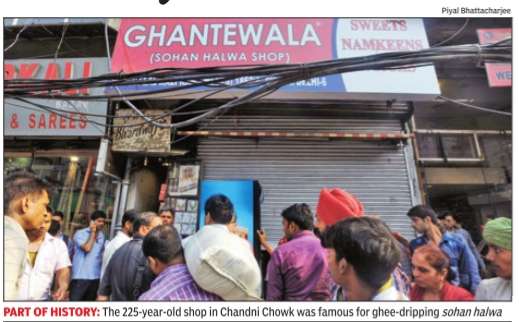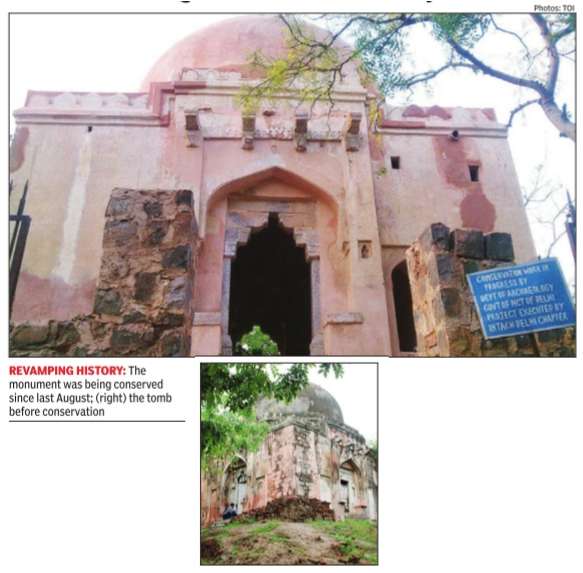Delhi: G
This is a collection of articles archived for the excellence of their content. |
Contents |
Gali Paranthe Wali
For Paranthe Wali Gali see Delhi: P
Gandhi Nagar
Notorious Market
Paras Singh, Jan 01 2017: The Times of India

A Dolce & Gabbana leather jacket! Not quite sitting in comfort among baby suits and gaudy women's wear, but then there is that distinctive logo sewn into the lapel: D&G. It also has paper labels imprinted with the logo, apparel details and the price: Rs 300! A quick glance at the ware in the shops lining the street confirms the revered brand is in great company with Zara and Giorgio Armani, Lacoste and Paul Smith. Also quietly peeping out from among the array are jeans with their “G&G“ logo gamely trying to mimic the venerated “D&G“.
Everything here costs a minute fraction of the real prices. That is why these streets of Gandhi Nagar in east Delhi figure in the list of `Notorious Markets' released annually by the Department of United States Trade Representative. The sanctity of brand names and trademarks has no meaning here. Reebok, Adidas and Nike are names that have been so routinely duplicated in Gandhi Nagar that they are disdained by buyers. Armani and D&G are the flavours of the season.
Located along the road skirting the Yamuna, this maze of colourful, crowded lanes is a haven for shoppers -and a hell for multinational brands. Although the market sells replicas of global design houses sourced from Kolkata, Ludhiana and China for prices ranging from Rs 50 to Rs 300, most of the products are manufactured in tiny units in the Trans-Yamuna areas of Dharampura, Kailash Nagar, Seelampur, Ajeet Nagar and Raghubar Pura. It is from Gandhi Nagar that the fake brands make their way to markets across the country .
Gandhi Nagar has come a long way since 1970, when it comprised a few outlets in Ashok Gali. Today it has over 10,000 stalls, and half a million people depend on the market for their livelihood. No wonder the shop owners are so touchy when the issue of intellectual property rights props up. “Yes, every one is honest, from police and income tax officials to government babus, everyone except the traders,“ huffs trader Purushottam Sharma. “Gandhi Nagar provides quality clothes to cover the bodies of India's teeming poor,“ he adds to clinch his argument.
Another trader argues, “What companies call counterfeit, we define it as local ingenuity for survival.“ This semantic absolution explains the proliferation of jackets, sweatshirts, jeans and shirts bearing the logos of Armani, Polo, Zara, Lacoste, Levis, Pepe, D&G and of Apple, Mercedes-Benz and Ferrari. Given this, Deshraj Malhotra, president of the Association of Whole Readymade Garment Market, is clearly being disingenuous when he says, “The issue of fakes is a ploy to defame us.“
But Gandhi Nagar's appearance in the Notorious Markets list means that the world has taken note of the wanton violation of IPR by traders here and in markets like Baiyun in Shanghai, Ikeja in Lagos and La Salada in Buenos Aires. The USTR expects the operators and the government to deal with the menace. When told this, Hukum Chand Gupta, president of the Gandhi Nagar Trad ers Association, mellows a little and admits, “Yes, some traders are forced to sell fakes to earn a bit, but it is not rampant here.“
The shop owners will not be overly worried, though. Officers at the Gandhi Nagar police station told TOI that they are “yet to receive any complaint about counterfeiting of their products in the market from any company“. Besides, the USTR report notes that the Indian government enforced no meaningful, effective measures after the earlier listing of Nehru Place, Gaffar Market, Tank Road and Sadar Bazar in the Notorious Markets list.
Ghantewala sweets, Chandni Chauk
The Times of India, Jul 02 2015

Avijit Ghosh & Richi Verma
ICONIC SHOP - Dwindling business rings down curtain on city's oldest mithai shop
When Ghantewala opened in 1790, Mughal emperor Shah Alam II ruled Delhi, Tipu Sultan was firmly in the saddle in Mysore and Paris still consumed by the French Revolution. The 225-year-old iconic sweet shop in Old Delhi's Chandni Chowk downed its shutters. A delectable chapter in the capital's culinary history is over. “It is difficult for me to talk about the shop right now.Please remember we owned it for eight generations. The thing is: falling sales made it an unprofitable venture for us,“ owner Sushant Jain told TOI over phone.
Ghantewala's ghee-dripping sohan halwa spawned serious fandom in the pre-cholesterol-obsessed era. “Rajiv Gandhi came here. I remember Mohd Rafi who arrived in a car. Even Morarji Desai used to get jalebis specially packed from this place. During Diwali, the shop owners would summon police to maintain order and manage the customers who would queue restlessly for mithais,“ recalled Ashok Arora, who owns Anarkali Bazar, an adjacent sari shop.
“The shop was a magnet for tourists. Dozens of foreigners would clutch at their travel guides and take selfies before the shop. Even now, when anybody asks for directions to my shop, I always say , next to Ghantewala. For me, it's a day of mourning,“ said Arora.
There are different versions how the shop got its name. It is said that the sweet shop was named after a clock tower located nearby . Another version is that the shop got its name from a school bell (ghanta). Apparently the Mughal emperor, who could hear the bell toll from his Red Fort residence, would ask for sweets from the shop located near the ghanta; hence the name.
Historians termed the closure of Ghantewala sweet shop as a huge loss to traditional Old Delhi. “It was probably the oldest and the most famous shop in the area. People associate their memories of Chandni Chowk with Ghantewala in the same way that one links Karim's to Jama Masjid. It was part of Shahjahanabad's intangible heritage,“ said A G K Menon, convener, INTACH Delhi Chapter.
There were two ghantewala shops in Chandni Chowk.The one closer to the Chandni Chowk's fountain, Ghante Wala Shahi halwai, had closed several years ago. The second one, located on the other side of the road, remained in business. There's even a lane named after it, Ghantewali gali. According to residents, the shop was divided between two brothers almost two decades ago. While the elder brother sold his share several years ago, the other portion was operated by Sushant.
Locals said business started dwindling over the last decade or so. As other shops expanded and new ones opened up, Ghantewala was barely able to cope, said a local trader.
The sweet shop finds mention in Mahmood Farooqui's book, Besieged. Quoting contemporary newspaper, Dehli Urdu Akhbar, it says, “The troops who can act with great daring outside...the moment they go around Jama Masjid and enjoy the qalaqaand of Ghantewala and its laddus, they lose all urge and determination to fight.“
The 1954 Hindi film, Chandni Chowk, starring Meena Kumari, also included scenes filmed before the famous sweet shop.
Late Wednesday afternoon, the shop was being cleaned out. A huge refrigerator was lifted out even as a bunch of onlookers gathered around the shop. A senior employee was upset at the development. “Heritage? What heritage are you talking about?“ he shouted. When the shutter was pulled down, he took a last look inside, wiped his sweat and walked away .
The Gole Market

Greater Kailash I
Revival of abused Lodi-era monument
The Times of India, Jun 01 2015

Richi Verma
Abused Lodi-era tomb gets new life
For decades, this Lodi-era monument served as a library , a venue for community gatherings and a makeshift living area for squatters. However, this unknown tomb located in a public park in upscale Greater Kailash I area has just been revived. The monument, which had fallen victim to neglect, deteriorated with time, and saw rapid encroachment through the years, was hand-picked for an elaborate conservation and protection programme by the India National Trust for Art and Cultural Heritage (Intach) in a collaborative project with the Delhi government's archaeology department.
The project started last August, and since then, a considerable difference can be seen in the historic building. Though located inside a central park near Nblock market, the monument has rarely seen any visitors.
“It is on a raised mound and clearly visible from the main road. Towards its south, there are a series of steps made at a later date. In the immediate surrounding or in the park, there are no other historic monuments. However, the Lodi-period monuments in the Zamrudpur village are in the vicinity , said officials.
Through the decades, a num ber of alterations were made to its original facade. “Cement plaster was used extensively and even a room was constructed near the dome which was razed. It took a lot of time and effort to remove the alterations without harming the structure.We managed to get hold of archival pictures from the 1950s which showed us how the building used to look like originally. This helped us recreate missing elements as well, said Intach officials.
Portions of the mehrab were missing and the niches were buried under the cement plaster. The red and blue hand running through the interiors were hardly visible and had to undergo chemical cleaning. “The medallions were defaced and all decorative elements suffered immense damage and decay from years of neglect, said an official.
The tomb stands on a mound about a height of 3.5m from the ground level around. “There is no mention of any enclosure wall by Zafar Hasan; however, there are some remains of a stone wall to the east of the tomb, which seems like a retaining wall. Further investigation need to be done in this regard, reads a description of the monument in the Intach listing.
Architecturally , the tomb has a square plan and has some unique features such as the sand stone brackets supporting the chajja, rectangular openings stone pillars, lintels and brackets, domed ceiling with bands in incised plaster etc which attributes the tomb to belong to either Tughlaq or early Lodi period.
“The tomb has been put to various uses in the past. It is located in a modern locality of Delhi, inside the DDA park and is prominently visible from the main road. Now that, the tomb is secured by the government, it will be conserved and restored appropriately by rectifying all wrong repair works done and by recreating lost features. The surrounding must also be developed after procuring land from the DDA.Once conserved and developed, the residents are definitely going to appreciate this unique historic structure in their locality and take pride in it, said an official.